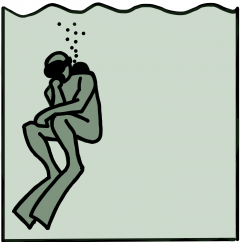After I expressed my worries about the commonly used criterium for the occurrence of Isobaric Counter Diffusion (ICD), namely a gas change in which the N2 fraction increases by more than a fifth of the drop in the He fraction, I learned (suggested by the OSTC source code, around lines 2220) about another (and much better motivated) criterium: Simply check if the leading tissue is taking up more N2 than it dumps He to the environment. That would mean that the net effect is an on-gassing of inert gases.
\(\Delta p_{He}<0,\quad \Delta p_{N_2}>0,\quad \Delta p_{He} + \Delta p_{N2} >0\)This sounds reasonable: If this is true for the leading tissue, the decompression is ineffective as the total inert gas pressure goes up.
So I implemented it in Subsurface. Turns out, this does not trigger where you expect it. For example for a 60m dive with 20min of bottom time on 18/45, forcing a gas change to air (i.e. high N2) at 45m does not trigger it: Yes, He in the tissue goes down and N2 goes up but He is so much faster that the net effect is still off-gassing.
But for the same dive, it triggers at a different, unexpected place: At the beginning of the ascent (at 58m to 54m). How does this come about? At the end of the bottom time (and also during the start of the ascent), the leading tissue is the second (with 8min of N2 half-time). After 20min bottom time, He is almost saturated but N2 still has a way to go. Thus, at the start of the ascent, pretty much off the bottom, He starts off-gassing while for N2, the depth difference is not really noticeable, so it is still on-gassing with positive net. So there actually is counter diffusion even without a gas change!
I guess, nobody would suggest that leaving the bottom at 60m would be dangerous. But this seems to be the only place where counter diffusion actually happens!
I tend to believe more and more that this whole ICD story is either not explained at all by a diffusion model (maybe because it is only relevant in the inner ear that does not follow this simple tissue+environment model) or it is totally bogus.
So I would like to hear from you, dear readers, do you have any experiences with ICD or could you suggest a dive profile where it should be relevant?


Hi Robert,
i’m pleased to hear that someone actually read my code and analised my way of detecting an IBCD condition. When i did the coding, first i implemeted the Burton rule. But then, more by accident, i discovered that when you do the Bühlmann equations, calculating tissue on- and offgassing, you more or less get the indication of IBCD condition at the same time “for free”. The OSTC code will also trigger if there is more He entering a tissue than N2 is leaving it. During my testing, i could trigger IBCD warnings also on (deco) gas changes, using very aggressive mix changes that no one would do in real dives. Moreover, i found that IBCD does happen quite a lot, even during “normal” ascents as you described, in one or more of the none-leading tissues. Often these IBCDs last only for a few seconds. As they are occuring in the none-leading tissue, they do not harm the overall deco, that is why i suppress them and generate warnings only on IBCD in the leading tissue. Even these leading-tissue IBCDs sometimes only last a few seconds, raising the tissue supersaturation by only a few percent. But i was also able to create scenarios where the GF went straight up to and beyond the 100% limit. It seemed that it would require intensive calculations to predict if an IBCD will stop soon or if it is of such a “runaway” type. Therefore when the OSTC gives an IBCD warning, it shows the current GF value at the same time, so one can see how fast and lasting the GF rising is. Last but not least: seeing no IBCD warnings in real dives is also something good!